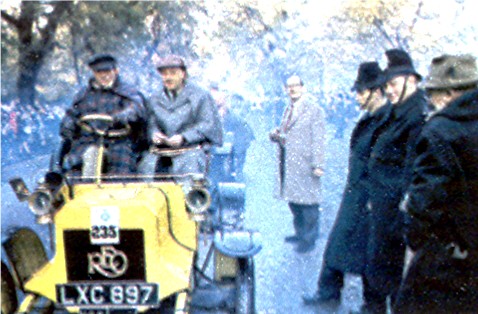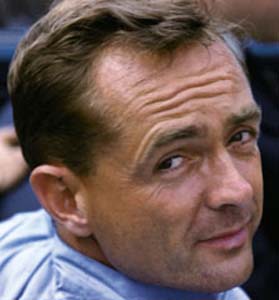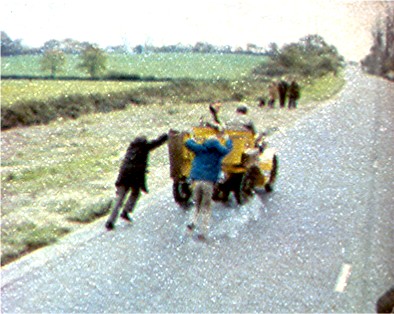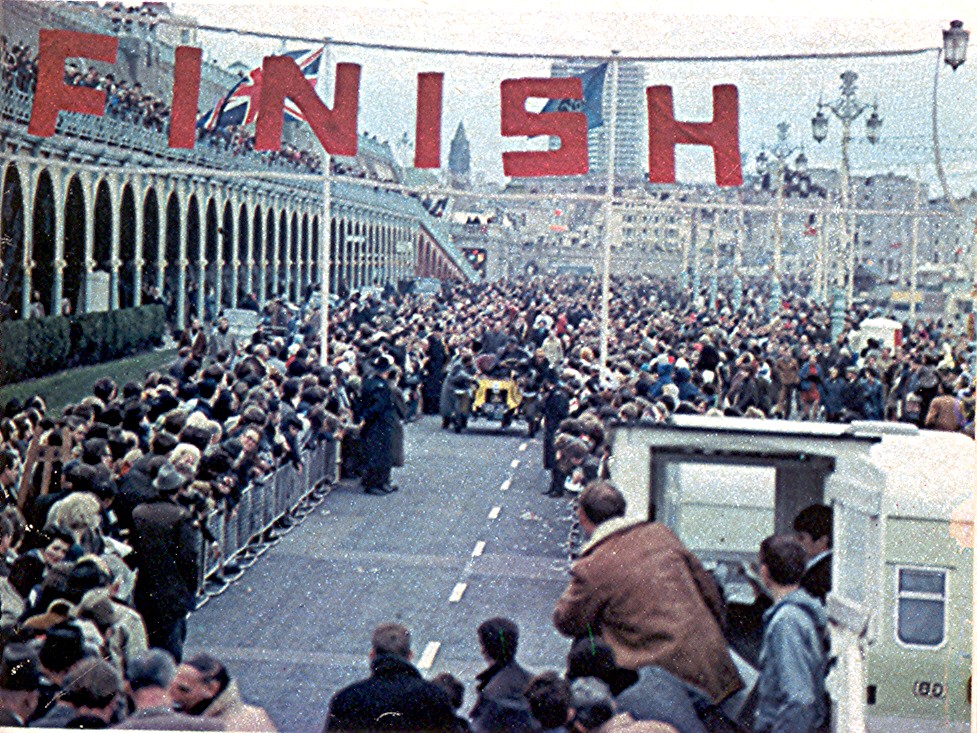WHO WOULD HAVE
BELIEVED IT OF THE OLD GIRL?
Emmy at 62 may have a few stiff joints, but read
about the day she ran 55 miles
By Jim McCay
Originally appeared in TV Guide, Jan 14, 1967
When
you're 62 years old and haven't kept up with the times, it's
an unexpected pleasure to be cheered by a million people. It did
happen, though, to Emmy, and this is the story of that day.
 Emmy
is a 1904 Reo automobile, a two-seater with a pop-up mother-in-law seat in
back, yellow in color, with a one-cylinder, 7.5 horsepower engine under
the floorboards. The normal rhythm is pop-pop-pop-bang, pop-pop-pop-bang.(left:
Emmy with Phil Hill driving and Jim McCay navigating) Emmy
is a 1904 Reo automobile, a two-seater with a pop-up mother-in-law seat in
back, yellow in color, with a one-cylinder, 7.5 horsepower engine under
the floorboards. The normal rhythm is pop-pop-pop-bang, pop-pop-pop-bang.(left:
Emmy with Phil Hill driving and Jim McCay navigating)
On the occasion of the 70th Anniversary of the Emancipation of the
Automobile, Emmy was brought out of retirement to enter the famous
London-Brighton run, that wonderfully, perfectly British affair in which
250 veteran cars attempt to make it from the Serpentine Lake in Hyde Park
to the waterfront in Brighton 55 miles away by 4 o'clock in the afternoon.
A veteran car, by definition, cannot have been manufactured any later than
1904, making Emmy one of the real late-model jobs. And the Emancipation of
the Automobile? That was the day in 1896 when it was no longer the law in
England for a car to be preceded by a man carrying a red flag.
 To
drive Emmy, the American Broadcasting Company engaged the former world
Grand Prix motor-racing champion, Phil Hill, only American to win that
honor. The writer [ABC sports commentator] was to be navigator.
(left: Gran Prix champion Phil Hill) To
drive Emmy, the American Broadcasting Company engaged the former world
Grand Prix motor-racing champion, Phil Hill, only American to win that
honor. The writer [ABC sports commentator] was to be navigator.
(left: Gran Prix champion Phil Hill)
The entire run was filmed for presentation on the network's Wide World of
Sports program next month [February 1968]. The team manager, riding in a
tender car, was Jim Leake, a wealthy Oklahoma television station owner and
collector of veteran and vintage cars. He owns 18 Rolls-Royces. He also
owns Emmy.
Chief engineer was Cdr. E. D. Woolley, G.M.- D.L.C., a dead ringer for his
namesake, the late actor Monty Woolley. Commander Woolley prepared the car
for the run and also rode in the tender to care for emergencies. "But it's
really all up to the driver now," he said.
There was also Leonard Potter. An Englishman, Leonard is distinguished by
a small mustache, extremely thick glasses, thinning hair and the
chain-smoking of tiny, thin cigars, which he keeps lighted until they are
about one-sixteenth of an inch long. For the day of the run, he wore a
World War I leather flying helmet.
Mr. Potter had tended to all of the pre-race arrangements. Now most of his
work was done. As he put it, "Well, there's nothing else I can do. I'm
going on ahead to arrange for the drinks."
This was Scuderia ABC, the racing team.
The morning of the race dawned clear-a good omen, since Emmy has no roof
and no windshield. Our starting position was No.235 at 8: 50 A.M.
Fifty-thousand people were gathered at the Serpentine in Hyde Park,
examining the cars and their drivers. It was quite a sight. There were
Benzes and Daimlers, Cadillacs and -Fords, Mercedes and Darracqs and
Stars. There were Wolseleys and Quadrants, a Milwaukee Steamer, a Pick and
a basket fore-car; De Dietrichs, De Dions, Decauvilles. Stanley Steamers
were there. So was a Royal Enfield Quadricycle, a Beeston Tricycle, a
Century Tandem. And a yellow Reo.
To Understand what happened that day, you must also understand a little
about Phil Hill. He is an intensely, visibly emotional man, quick to
anger, slow to smile. When laughter comes, it is explosive,
throwing-the-head-back laughter. He is a loner, a bachelor in his late
30's who lives in the solitude of his Santa Monica, Cal., home with a
butler and his collections of vintage cars, player-pianos and music boxes.
On the Sunday before the London- Brighton run he had been driving at a
Riverside, Cal., in the ultramodern Chaparral, an automatic-transmission
racing car with a strange wing mounted above the back for stability. It
goes over 200 mph.
 The
speed of the Reo is a top of about 20. But I knew how Phil would be. He
was as intense, as edgy, as irritable just before we fired up Emmy as he
had been at Riverside. He was a race driver eager to get going; a race
driver, to be sure, in period costume - Inveness cape-coat and a1l -
climbing into an untested 1904 Reo; but a race driver with one object in
mind, to get to Brighton before 4 o'clock. The
speed of the Reo is a top of about 20. But I knew how Phil would be. He
was as intense, as edgy, as irritable just before we fired up Emmy as he
had been at Riverside. He was a race driver eager to get going; a race
driver, to be sure, in period costume - Inveness cape-coat and a1l -
climbing into an untested 1904 Reo; but a race driver with one object in
mind, to get to Brighton before 4 o'clock.
At 8: 45 Jim Leake swung the crank. She started. The first major obstacle
had been conquered.
(Above: Emmy needed the occasional push)
We moved up into position, officials waving us toward the start line,
spectators shouting encouragement. "The engine sounds very strange," Phil
said."Very, very strange”
Then the starter waved the Union Jack and there was no turning back.
Off we went, making about 10 miles an hour and immediately I realized that
without a windshield in front of you, even 10 feels very fast. The car
felt fine to me, as we putted out of Hyde Park, headed for Westminster
Bridge. “It's going to stop,” Phil said, waving one arm in the air. “Can't
you feel it, for heaven's sake? It sounds all wrong."
Never argue with a race driver. A hundred yards short of Westminster
Bridge the Reo stopped without warning. She couldn't have stopped in a
more embarrassing place. She had shown her fragility in a setting of
utter, awesome stability. A few hundred feet to the right stood the mass
of Westminster Abbey. One felt that inside, the shade of George III was
smiling under his marble slab. He knew that colony would never make it
alone.
Just ahead, Big Ben in his tower loomed over the helpless Americans and
their American automobile.
Something had happened to our tender car: Jim Leake and Commander Woolley
were nowhere in sight. But this time the British came to our help.
Several people ran out from the curb, volunteering to push.
Our camera helicopter hovered overhead recording the scene, and at that
moment, Big Ben struck 9.
As the bell tolled the fifth time, the engine caught. We were running.
Down the other side of the bridge we went, leaving the Thames behind, on
into Lambeth. In a half mile, we stopped again. A continuous stream of
words came from Phil Hill, cursing the car and the engine, ordering me out
so he could pull up the seat and the floorboards and see what was wrong.
"She's flooding but I don't know why," he shouted.
"Reach under the floorboards and put your finger on the spark plug," Phil
said. I did. "Well, that's it, then, the spark plug isn't working."
"What," I asked, "would have happened to my finger if it was working?"
"You would have gotten a shock," he said.
As we stopped, I pulled out the tool box, looking for a spare spark plug.
It contained a jumble of ancient hammers and screwdrivers and odd-looking
tools. Sure enough, though, there was a brand-new spark plug.
We unscrewed the old one. The new one didn't fit. All seemed lost.
TV producer Lou Volpicelli was there. "Phil," he said, "we must get to
Brighton. It's been almost an hour and we've only gone two miles. We have
53 to go. Will you let us tow you for a few miles with the camera car?"
Hill exploded.
"No, I will not let you tow us. I came here to drive from London to
Brighton and that's what I'm going to do or die in the attempt!"
Lou retreated.
A cameraman appeared with a piece of sandpaper, which Hill used to clean
off the old, sooty, spark plug. It worked. In a mile or so, when the
carburetor started to flood again, Phil told me to reach under the
floorboards and turn off the gas supply by means of a one-inch-long lever.
When I did, the engine improved right away, but only until the cylinder
began to starve for fuel. "Turn it back on!"
For the rest of the day, I was to sit in a hunched-forward position
turning that little lever on or off every half mile or so.
About then, real disaster struck. As Phil tried to shift from low to high
- there are only two gears on the car - something snapped.
"We've had it," he said. "That damn weld has given way." He referred to a
part in the high-gear mechanism that had been repaired the night before.
We found he was right when we lifted up the seat this time. There was no
solution except another welding job.
Suddenly, in the moment of greatest need, our tender car appeared. Jim
Leake and Commander Woolley ran up, explaining that they had been caught
in a bad traffic jam.
Woolley had a possible solution. He knew a garage a few miles ahead that
might undertake the welding job. He would drive with the part and we
should try to catch up in first gear.
A half-hour later, shaking and coughing along in low, the little yellow
Reo was flagged down by Mrs. Woolley, standing in the middle of the road,
waving us into a gas station. "It's almost fixed," she shouted happily.
"Everything's going to be lovely."
The next several miles were sheer pleasure. After some balkiness at first,
the gear selector began to slide smoothly into high each time. I was
getting to be an expert, albeit a weary one, at turning that little fuel
control thing on and off. Phil was enjoying himself now.
"Feel that wind," he said. "We must be doing almost 25."
The race driver in him began to surface again. He looked forward at our
camera car, which was running in front of us, recording our progress from
a camera braced on the tailgate.
"They're going too slow," he said. "Let's pass them."
"Pass them?" I said. "Phil, we can't pass our camera car. That's what
we're here for!"
"Not me," he said. "I'm here to drive to Brighton. Let's go!"
He squeezed the bulb of the old horn. It sounded like a duck call, but the
camera car got the message when I waved at them frantically. They speeded
up.
Now it was time for our scheduled stop at the Chequers Tavern for rest and
refreshment. From here on, there was just one major hazard more, the
infamous pyecombe Hill, just five miles from the finish.
At the tavern, everything was as merry as a Charles Dickens Christmas
party. The mugs of bitter were drained, and the odyssey resumed.
Merrily we rolled along, Phil and Emmy and I, on a turnpike now, or dual
carriageway as the British call it. The engine was in fine shape as long
as we continued the on-off business with the fuel control. We breezed
alongside Gatwick Airport, which is the London version of New York's La
Guardia field. Just as we were about to go underneath the modern terminal
1 building (it's built on pilings across the turnpike), the top of one of
our lanterns flew off. Parts for 1904 Reos are not easy to come by, so we
stopped and I ran back about a quarter of a mile to retrieve it.
Pyecombe Hill, the bugaboo of many of the cars in the race, was no match
for our valiant little Emmy. She took most of it in high, then conquered
the summit with a powerful few growls in low. No sooner were we over the
hill, though, than something popped and our water supply started cascading
over the roadway. Again, it was Commander Woolley and Jim Leake to the
rescue. The commander quickly saw that the ancient water hose had simply
come off. He put it back together with a string, securing it with a double
bow.
With that fixed, it figured to be a breeze, all downhill into Brighton,
only five miles away.
But the road to Brighton suddenly became one huge traffic jam, bumper to
bumper and stopped, as far ahead as the eye could see. Phil Hill pulled
the car out onto the right-hand side of the road, smack in the path of
oncoming traffic. The old cars were allowed to do that, but the traffic
coming at us was particularly heavy and fast right now. I began to wave
them over, but he stopped me. "I'll handle this," he said, and began to
make Emmy stagger down the road, as if out of control. "That'll get them
over," he said. It sure did.
Three-thirty now and no time to spare, as we entered the town of Brighton.
The traffic got heavier and heavier, and finally stopped us completely at
a complex intersection with a traffic light. The light seemed endless as
the minutes fled by; 20 to 4 - and 4 o'clock, remember, was the deadline.
Arrive after 4 and you have lost the day.
The traffic moved, ever so slowly, but we had just two blocks to go.
One block now, and then, ahead, there was the sea!
Two hundred yards to the finish line, and what a crowd. One-hundred
thousand Englishmen stood along the beach and the waterfront, others
craned their necks from the high road that overlooks the sea.
Ten minutes to 4, and we had it made.
Then the car stopped.
It just stopped, without a warning, without a groan or a complaint,
without any apparent rhyme or reason. Floorboards and seat were thrown out
again. Hill and the Commander tried everything. The crowd cheered and
shouted encouragement.
"It's no use, she just won't go!"
"We're going to get this thing across the line," I said. I was beginning
to sound like Phil Hill.

The former champion of the world leaped back into the driver's seat as I
began to push. The car moved, ever so slowly at first, then more smoothly.
If my wind lasted, I saw we could make it.
On either side of the car, the huge crowd formed solid walls, swaying and
shouting. "Come on Yanks, you can do it." "Good on ya, lads!"
And behind the recognizable words, a roar that obliterated the sound of
the sea breaking on the beach, a friendly roar that surrounded us like a
coat, a roar that grew and grew as each laborious yard of pavement fell
behind us.
At four minutes to 4, we rolled under the finish-line banner. We made the
London-Brighton run at an average speed of 7.86.miles per hour.
And there sat little Emmy, smoking a bit, with the right front fender
dangling from apiece of wire, but with mother-in-law seat sitting
erect, yellow paint unscratched and the tiny pennant they gave us at the
finish waving proudly from her hood. "London to Brighton, 1966," it read.
"Seventieth Anniversary of the Emancipation of the Automobile."
|
|